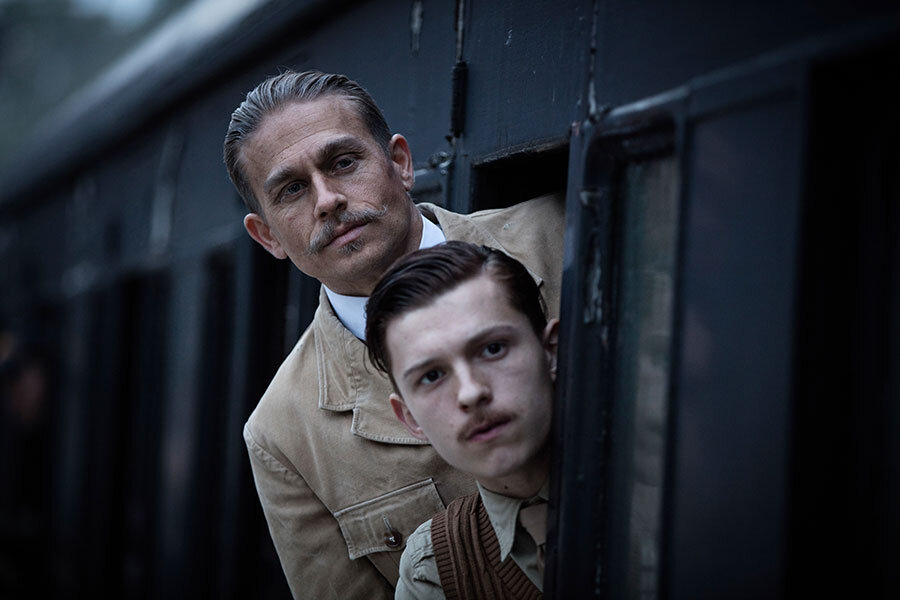'The Lost City of Z' is only fitfully successful as a psychological portrait of a burgeoning obsessive
Loading...
“The Lost City of Z,” which is about Lt. Col. Percival Fawcett (Charlie Hunnam), the real-life British Army officer who obsessively sought to uncover the ancient civilization he believed was buried in the Amazonian jungle, is being talked about as a throwback to a classical era of Hollywood filmmaking.
It’s true that the film has an unhurried narrative sweep and a cast of stalwarts that, superficially at least, would not look out of place in an old Errol Flynn movie. But it doesn’t take long to realize that “The Lost City of Z,” written and directed by James Gray and adapted from the 2009 nonfiction bestseller by David Grann, is a far stranger experience than those golden age films. It’s much closer to the hallucinatory quest epics that arose in the 1970s, films like Francis Ford Coppola’s “Apocalypse Now” or Werner Herzog’s great “Aguirre, the Wrath of God,” in which a crazed conquistador leads a mad mission into the Amazonian jungles in search of gold.
“The Lost City of Z” cannot compare in intensity with Herzog’s film, with its magisterial delirium. But, in his own way, Gray is as unremittingly obsessed as Herzog. He recognizes that Fawcett’s folly mirrors the magnificent obsession of filmmakers who are driven, however unsuccessfully, to fulfill the furthest reaches of their art.
Fawcett was sent in 1906 to eastern Bolivia by the Royal Geographical Society in order to map the previously uncharted border with Brazil. Leaving behind his pregnant wife, Nina (a fine Sienna Miller), he takes in tow an old Army buddy, Henry Costin (a bearded, almost unrecognizable Robert Pattinson), and sets out on a cartographic mission that inevitably becomes much more than that when Fawcett uncovers ancient pottery shards and other evidence that, he is convinced, point to the existence of an earlier, heretofore unimagined civilization in the Americas.
The idea that this civilization would predate Britain’s is one of many reasons why his findings are routinely dismissed by the poobahs of the Royal Geographical Society, who, despite their lauding of Fawcett’s heroism, sniff at his lowborn origins. (“He’s been rather unfortunate in his choice of ancestors,” one member says.) Fawcett and his crew encounter natives in the jungle both hostile and helpful; in one of the film’s stirring mini-set pieces, he leads his men in a chorus of “Soldiers of the Queen” as they, on a raft, are being shot up with arrows. He does this not to assert a moral superiority but, rather, as a gesture of amity. And it works. His contention, as he makes clear upon his return to England after the first expedition, is that these savages are not savages. “We are all made of the same clay,” he asserts.
As a psychological portrait of a burgeoning obsessive, “The Lost City of Z” is only fitfully successful. With his staunch, square-jawed features, Hunnam certainly looks the part of a champion explorer, but the heedless drive that compelled this quixotic adventurer to repeatedly leave behind his family and reenter the jungles is only spottily dramatized. (Interrupted by his near-fatal military service in World War I, Fawcett underwent two more expeditions in the next 20 years; the last one, accompanied by his son, played as an adult here by Tom Holland, was ill-fated.) Gray is interested in Fawcett less as a person than as a metaphor for the transcendent overreach of which man is capable.
Gray has never been a master storyteller, but he has a rare gift for creating visual tableaux that encompass the widest breadth of emotion in a single shot. (The final image from the extraordinary, and extraordinarily overlooked, “The Immigrant” is one of the great closers in cinema.) In “The Lost City of Z,” he strikes these images again and again. The cinematographer is Darius Khondji.
You may question why we don’t see more of the close-up horrors of the jungle ordeal, or why the film only sporadically touches on the exasperations of his home life or the depredations of the British Empire, but Gray is after more unworldly game. Fawcett is caught in a spiritual limbo; he’s not a proper Englishman but not a native of the jungles, either. He’s a man without a country who nevertheless sees the Amazon, with its dense mysteries, as his true abode. He sees a shining light in this heart of darkness.
You can feel in this film, as you can in Herzog’s best movies, the ethereal pull that the uncanny can exert on a man. When Fawcett says, “We know so little of this world,” he is speaking not as a cartographer but as an ecstatically bewildered citizen of the universe. Grade: B+ (Rated PG-13 for violence, disturbing images, brief strong language, and some nudity.)





